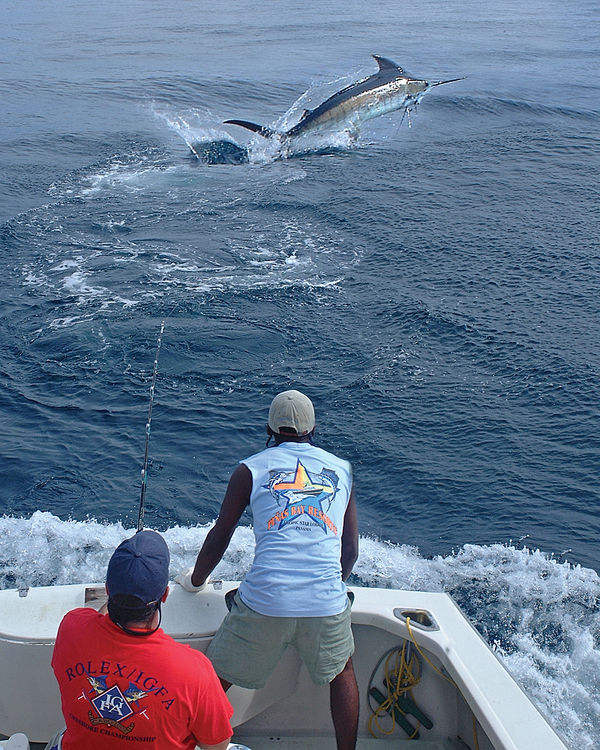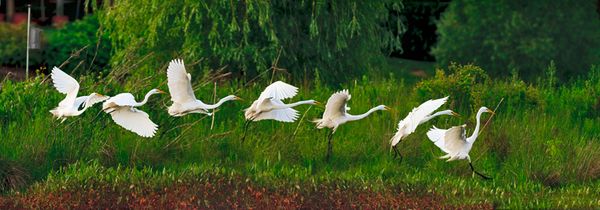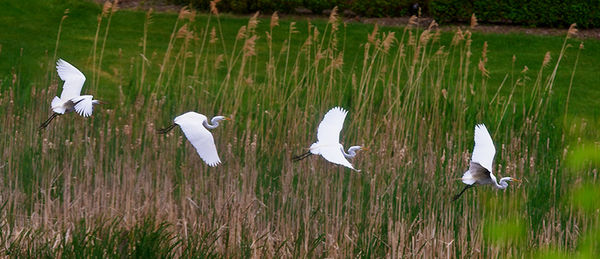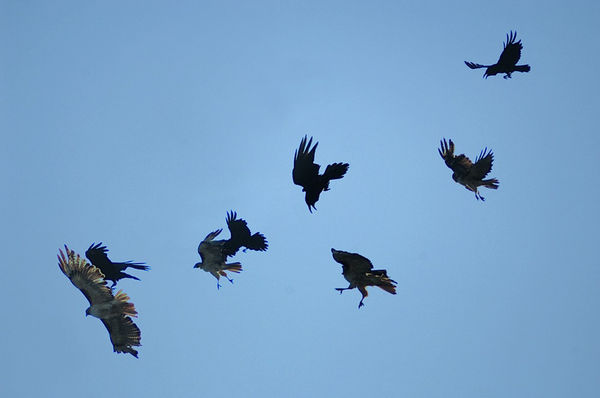Blurred shots?
Aug 28, 2011 04:20:33 #
Hi,
New to DSLR cameras - I have a Nikon D3000 DSLR and boy do I need help........
Went to a high school football to take pictures mainly of the Marching band. I had it set on Sports and continious (burst). Out of 141 shots 80 of them are so blurred you can barely tell what shot it was.
Please tell me what did I do so wrong. I messed up some awfully good shots.
Shirley
New to DSLR cameras - I have a Nikon D3000 DSLR and boy do I need help........
Went to a high school football to take pictures mainly of the Marching band. I had it set on Sports and continious (burst). Out of 141 shots 80 of them are so blurred you can barely tell what shot it was.
Please tell me what did I do so wrong. I messed up some awfully good shots.
Shirley
Aug 28, 2011 06:47:40 #
jdtx
Loc: SA, Tx.
I am guessin' it was pretty dark, even though the stadium lights were on..so most likely a combination of things, too slow a shutter speed, too low of an ISO setting, camera shake..I took some at a high school football game on Friday night also, after the sun went down I had to crank up the ISO a lot and open the shutter all the way up..2.8 on that particular lens..got some decent shots..although from where I was there was really no such thing as a good shot..
Aug 28, 2011 10:04:18 #
ALWAYS take a few test shots for review so you can make adjustments. Because as light changes, so will your camera settings. Sports mode is a full auto setting. I'm not sure you can raise the ISO in that setting. I would have switched to Tv (Shutter Priority) and raised the ISO until a high enough shutter speed was possible to stop the action. You would want a shutter speed around 1/200 sec. to have sharp photos in this situation.
Aug 29, 2011 03:05:58 #
Ah, the burst mode problem. This echoes discussions we had long before a digital camera existed.
Cutting to the chase: Motor drives have one overriding purpose - to keep your eye on the action, and allow instantaneous shooting of the exact, best moment. You just need to learn to "see" as a photographer.
No experienced photographer holds down the shutter release on a motor drive just to hear rapid clicking. Always, shooting in this mode only allows the expectation of a "happy accident." Maybe one frame in 50 is good. Or not (much more common.)
Conversely, a professional photographer, with the same camera, will keep an eye on the action, and methodically click, one frame at a time, frozen moments of the action. In the same time the first person shoots 65 frames, the pro will shoot 10 or 12. The difference, the first photographer's burst mode will be lucky to have 1-2 acceptable images, but not one of them perfect. The pro will have 7 or more perfect images.
In digital, even though the "film" is now "free," it does not mean you need to burst fill your memory card. It is a much better exercise to learn to see, which involves not only composition, but the ability to be predictive of action. In the old days, it also meant selecting the right film and exposure for the subject in question.
The greatest journalistic photographers speak of the momentous moments they never saw... because their shutters were open, the viewfinder obscured in blackness, at the very moment which made history.
Where burst mode works: The Kentucky Derby. One photographer needs to cover the race from 6 angles. Five of the positions are motor driven cameras on tripods with assistants manning them. Basically, each of the remote cameras is fired as the horses first come into view at the camera's fastest burst mode. It used to be one 36 exposure roll of film. The pro, however is squeezing off one shot at a time as the horses reach the finish line.
I once photo edited an inexperienced photographer attempting to shoot a model walking toward him. A digital shoot, he shot 120+ images. Not one featured the model's walking legs in the right, appealing position. All of them were gawky and awkward looking. He did not know that the way you shoot a "walking model" shot is to NOT have the model walk, but rather "rock" in a single position, not moving forward, but half stepping as IF walking. In this way, the legs can be perfect. Every time. Plus, in the days of NO autofocus, it was an easy to get everything perfect.
The posted image involved no motor driven sequence, but was assisted by a motor drive to allow firing precisely at the right moment. When shooting any sport, you end up holding a camera to your face quite a bit of the time. However, it's always one shot at a time.
Cutting to the chase: Motor drives have one overriding purpose - to keep your eye on the action, and allow instantaneous shooting of the exact, best moment. You just need to learn to "see" as a photographer.
No experienced photographer holds down the shutter release on a motor drive just to hear rapid clicking. Always, shooting in this mode only allows the expectation of a "happy accident." Maybe one frame in 50 is good. Or not (much more common.)
Conversely, a professional photographer, with the same camera, will keep an eye on the action, and methodically click, one frame at a time, frozen moments of the action. In the same time the first person shoots 65 frames, the pro will shoot 10 or 12. The difference, the first photographer's burst mode will be lucky to have 1-2 acceptable images, but not one of them perfect. The pro will have 7 or more perfect images.
In digital, even though the "film" is now "free," it does not mean you need to burst fill your memory card. It is a much better exercise to learn to see, which involves not only composition, but the ability to be predictive of action. In the old days, it also meant selecting the right film and exposure for the subject in question.
The greatest journalistic photographers speak of the momentous moments they never saw... because their shutters were open, the viewfinder obscured in blackness, at the very moment which made history.
Where burst mode works: The Kentucky Derby. One photographer needs to cover the race from 6 angles. Five of the positions are motor driven cameras on tripods with assistants manning them. Basically, each of the remote cameras is fired as the horses first come into view at the camera's fastest burst mode. It used to be one 36 exposure roll of film. The pro, however is squeezing off one shot at a time as the horses reach the finish line.
I once photo edited an inexperienced photographer attempting to shoot a model walking toward him. A digital shoot, he shot 120+ images. Not one featured the model's walking legs in the right, appealing position. All of them were gawky and awkward looking. He did not know that the way you shoot a "walking model" shot is to NOT have the model walk, but rather "rock" in a single position, not moving forward, but half stepping as IF walking. In this way, the legs can be perfect. Every time. Plus, in the days of NO autofocus, it was an easy to get everything perfect.
The posted image involved no motor driven sequence, but was assisted by a motor drive to allow firing precisely at the right moment. When shooting any sport, you end up holding a camera to your face quite a bit of the time. However, it's always one shot at a time.
Squeezing off the shot at the right moment. Photo by Richard Brown

Aug 29, 2011 21:07:41 #
chauncey
Loc: Rochester, Mi
I most definitely disagree with the idea of not using rapid fire, called AI Servo by canon shooters for without it I would not have captured series like these.
The key is having an understanding how auto focus works and what kind of contrast is necessary for the camera to "lock onto" that subject and...whether you have the camera properly set-up for the various scenarios. A bird in flight requires a different set-up that does a football game.
The key is having an understanding how auto focus works and what kind of contrast is necessary for the camera to "lock onto" that subject and...whether you have the camera properly set-up for the various scenarios. A bird in flight requires a different set-up that does a football game.



Aug 29, 2011 22:22:25 #
PhotoArtsLA wrote:
The posted image involved no motor driven sequence, but was assisted by a motor drive to allow firing precisely at the right moment. When shooting any sport, you end up holding a camera to your face quite a bit of the time. However, it's always one shot at a time.
The posted image involved no motor driven sequence, but was assisted by a motor drive to allow firing precisely at the right moment. When shooting any sport, you end up holding a camera to your face quite a bit of the time. However, it's always one shot at a time.
I can certainly understand where you're coming from here as a pro. And If I want to be a Pro I would most certainly be better off learning when is the best time to take the shot rather than firing off a string of 10 to get it. But I'm not a pro. I probably never will be. But I still want to get that picture of my son as he makes that great catch or my daughter just as she lands the triple back flip or what ever they may do. I guess my point is, as an amateur, how many of these moments do I not get in the interest of learning how to shoot like a pro?
Aug 29, 2011 22:49:01 #
I have to disagree about needing autofocus to shoot birds flying parallel to the photographer. Especially at the apparent distance shown.
As to the idea of shooting birds, here's a one shot at a time attack of a crow on a hawk in the sky above my Daylight Stage.
300mm f/2.8, manual focus, as in OLD lens (480mm equivalent due to the DSLR crop,) on a Nikon DSLR, handheld (a hassle with the weight) where I was pleased with the fact my old sport focusing skills are somewhat intact. Not that it wasn't a bit of an adrenaline rush.
Each of the four composite images has a separate focus as the birds moved in 3D space. Note the changing scale of size over time. The Nikkor 300/2.8 has a great, smooth focus ring for its internal focus system.
As to the idea of shooting birds, here's a one shot at a time attack of a crow on a hawk in the sky above my Daylight Stage.
300mm f/2.8, manual focus, as in OLD lens (480mm equivalent due to the DSLR crop,) on a Nikon DSLR, handheld (a hassle with the weight) where I was pleased with the fact my old sport focusing skills are somewhat intact. Not that it wasn't a bit of an adrenaline rush.
Each of the four composite images has a separate focus as the birds moved in 3D space. Note the changing scale of size over time. The Nikkor 300/2.8 has a great, smooth focus ring for its internal focus system.
To Live and Die in L.A. - Bird Fight by Richard Brown

Aug 30, 2011 16:09:46 #
Ugly Hedgehog Newsletter wrote:
Hi,
New to DSLR cameras - I have a Nikon D3000 DSLR and boy do I need help........
Went to a high school football to take pictures mainly of the Marching band. I had it set on Sports and continious (burst). Out of 141 shots 80 of them are so blurred you can barely tell what shot it was.
Please tell me what did I do so wrong. I messed up some awfully good shots.
Shirley
New to DSLR cameras - I have a Nikon D3000 DSLR and boy do I need help........
Went to a high school football to take pictures mainly of the Marching band. I had it set on Sports and continious (burst). Out of 141 shots 80 of them are so blurred you can barely tell what shot it was.
Please tell me what did I do so wrong. I messed up some awfully good shots.
Shirley
We just had a big discussion about Sports mode on Canon SX30IS cameras in another forum a couple days ago. You might see if you can find that for more detail. In short, Sports mode is too generic on digital cameras and can't define whether it's a race car, a passing bicycle, or a football player. Apparently it sometimes works for beginners but most times doesn't and makes everybody disappointed and frustrated.
You have to use a preset automation where you can have shutter priority, set about 1/1000th of a second shutter speed, and change everything else like aperture, ISO, etc. to get enough light into the sensor for the right exposure.
Just forget the Sports setting, it's useless. You can probably use P (program) mode, set the shutter at 1/1000th or higher and all the other stuff will adjust automatically to get a decent exposure.
In the other forum, the lady used 1/2000th second in bright daylight and was successful. Indoors in lower light, you'll likely have use a longer exposure than that but still stay up around 1/1000th.
It's also very hard to use a long zoom and get decent high shutter speed sports shots without handshake blur so you should use a mono-pod or tripod, even if you're sitting down.
Hope that helps.
If you want to reply, then register here. Registration is free and your account is created instantly, so you can post right away.



